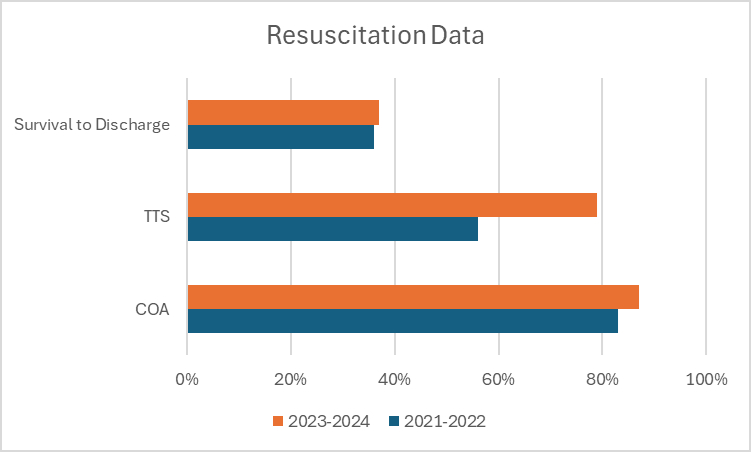Final ID: Sa404
Implementation of a Nurse-Centric Resuscitation Institute and the Impact on Quality Metrics
Abstract Body: Introduction: Healthcare organizations evaluate resuscitation using a wide array of methods. OThe American Heart Association’s (AHA) Get With the Guidelines-Resuscitation® (GWTG-R) database facilitates the collection of data to develop evidence-based guidelines. The four main metrics include time to shock (TTS), time to epinephrine administration, confirmation of airway (COA), and arrest monitored/witnessed. An academic health system (AHS) identified a need for improving how resuscitation data was translated at the bedside. Prior to the COVID-19 pandemic, resuscitation data within the AHS was focused on GWTG-R metrics for reporting only. The AHS’s Nursing Professional Development (NPD) department identified inaccuracies in data collection and minimal educational resources for improvement.
Hypothesis: Would a nurse-centric Resuscitation Institute impact quality survivability metrics at an AHS?
Goals: The NPD department reviewed GWTG-R data and survival to discharge at two hospitals. In 2021, the NPD department developed a team comprised of a data abstractor and resuscitation coordinator (NPD practitioner). The goal of this team was to improve data collection and translate identified needs from the data into resuscitation education and process improvement.
Approach: The team found gaps in documentation, education, and emergency response process. GWTG-R metrics COA, TTS, and survival to discharge were lower than national benchmark and an abundance of resuscitation events were occurring than estimated. Descriptive data for GWTG-R 2021-2022 metrics identified gaps in guideline adherence and documentation standards: COA 83%, TTS 56%, and survival to discharge 36%. Based on these findings, approval from administration allowed the team to expand into a nurse-centric Resuscitation Institute comprised of three data abstractors, a resuscitation coordinator, and program manager. The Institute now collects data across the AHS on resuscitation events, and collaborates with NPD practitioners, leaders, providers, and emergency responders.
Results: Since implementation of the Institute in 2023-2024 percentage increases revealed an improvement in survivability metrics: COA 87%, TTS 79%, and survival to discharge 37%.
Conclusion: The Resuscitation Institute used nurses and survivability quality metrics to create a multifaceted approach to education and process improvement that improved early recognition, optimal resuscitation practices and post-cardiac arrest care.
Hypothesis: Would a nurse-centric Resuscitation Institute impact quality survivability metrics at an AHS?
Goals: The NPD department reviewed GWTG-R data and survival to discharge at two hospitals. In 2021, the NPD department developed a team comprised of a data abstractor and resuscitation coordinator (NPD practitioner). The goal of this team was to improve data collection and translate identified needs from the data into resuscitation education and process improvement.
Approach: The team found gaps in documentation, education, and emergency response process. GWTG-R metrics COA, TTS, and survival to discharge were lower than national benchmark and an abundance of resuscitation events were occurring than estimated. Descriptive data for GWTG-R 2021-2022 metrics identified gaps in guideline adherence and documentation standards: COA 83%, TTS 56%, and survival to discharge 36%. Based on these findings, approval from administration allowed the team to expand into a nurse-centric Resuscitation Institute comprised of three data abstractors, a resuscitation coordinator, and program manager. The Institute now collects data across the AHS on resuscitation events, and collaborates with NPD practitioners, leaders, providers, and emergency responders.
Results: Since implementation of the Institute in 2023-2024 percentage increases revealed an improvement in survivability metrics: COA 87%, TTS 79%, and survival to discharge 37%.
Conclusion: The Resuscitation Institute used nurses and survivability quality metrics to create a multifaceted approach to education and process improvement that improved early recognition, optimal resuscitation practices and post-cardiac arrest care.
More abstracts on this topic:
A Clinical Trial of Healthy Food Subsidies and Behavioral Interventions to Increase Fruit and Vegetable Purchasing in an Online Store
Hua Sophia, Klaiman Tamar, Dixon Erica, Volpp Kevin, Putt Mary, Coratti Samantha, White Jenna, Hossain Mohammad, Posner Hannah, Wang Erkuan, Zhu Jingsan, John Aileen
Cardiovascular Stroke Nursing Best Abstract Award: Digital Health-Based Interventions Improve Healthy Behaviors, Weight Loss, and Psychological Well-Being in Older Adults at Risk for Cardiovascular DiseasCandelaria Dion, Reyes Andrew Thomas, Serafica Reimund, Hildebrand Janett, Cacciata Marysol, Sta. Maria Axel, Lee Jung-ah, Stromberg Anna, Evangelista Lorraine

